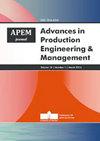Increasing Sigma levels in productivity improvement and industrial sustainability with Six Sigma methods in manufacturing industry: A systematic literature review
IF 2.5
3区 工程技术
Q2 ENGINEERING, MANUFACTURING
引用次数: 7
Abstract
Industrial sustainability is an important attribute and becomes a parameter of the business success. Quality improvement with an indicator of increasing process capability will affect productivity improvements and lead to industrial competitiveness and maintain industrial sustainability. The purpose of this paper is to obtain a relationship between the consistency of the DMAIC phase to increase the sigma level in productivity improvement and industrial sustainability. This paper applied for a systematic literature review from various sources of trusted articles from 2006 to 2019 using the keywords “Six Sigma, Productivity, and Industrial Sustainability.” A matrix was developed to provide synthesis and summary of the literature. Six Sigma approach has been successful in reducing product variation, defects, cycle time, production costs, as well as increasing customer satisfaction, cost savings, profits, and competitiveness to maintain industrial sustainability. Extraction and synthesis in this study managed to obtain seven objectives value that found a consistent relationship between the DMAIC phase of increasing sigma levels, productivity, and industrial sustainability. The broad scope of Six Sigma literature is very beneficial for organizations to understand the critical variables and key success factors in Six Sigma implementation, which leads to substantial long-term continuous improvement, the value of money, and business.用六西格玛方法在制造业中提高生产力改进和工业可持续性的西格玛水平:系统的文献综述
工业的可持续性是一个重要的属性,并成为企业成功的一个参数。以提高工艺能力为指标的质量改进将影响生产率的提高,并导致工业竞争力和保持工业的可持续性。本文的目的是获得DMAIC阶段的一致性,以提高西格玛水平的生产力提高和工业可持续发展之间的关系。本文以“六西格玛、生产率和工业可持续性”为关键词,对2006年至2019年的各种可信文章进行了系统的文献综述。开发了一个矩阵来提供文献的综合和总结。六西格玛方法在减少产品变化、缺陷、周期时间、生产成本,以及提高客户满意度、成本节约、利润和保持工业可持续性的竞争力方面取得了成功。本研究的提取和合成获得了七个目标值,发现DMAIC阶段增加西格玛水平,生产力和工业可持续性之间存在一致的关系。六西格玛文献的广泛范围对组织理解六西格玛实施中的关键变量和关键成功因素非常有益,这导致了实质性的长期持续改进,金钱和业务的价值。
本文章由计算机程序翻译,如有差异,请以英文原文为准。
求助全文
约1分钟内获得全文
求助全文
来源期刊

Advances in Production Engineering & Management
ENGINEERING, MANUFACTURINGMATERIALS SCIENC-MATERIALS SCIENCE, MULTIDISCIPLINARY
CiteScore
5.90
自引率
22.20%
发文量
19
期刊介绍:
Advances in Production Engineering & Management (APEM journal) is an interdisciplinary international academic journal published quarterly. The main goal of the APEM journal is to present original, high quality, theoretical and application-oriented research developments in all areas of production engineering and production management to a broad audience of academics and practitioners. In order to bridge the gap between theory and practice, applications based on advanced theory and case studies are particularly welcome. For theoretical papers, their originality and research contributions are the main factors in the evaluation process. General approaches, formalisms, algorithms or techniques should be illustrated with significant applications that demonstrate their applicability to real-world problems. Please note the APEM journal is not intended especially for studying problems in the finance, economics, business, and bank sectors even though the methodology in the paper is quality/project management oriented. Therefore, the papers should include a substantial level of engineering issues in the field of manufacturing engineering.
 求助内容:
求助内容: 应助结果提醒方式:
应助结果提醒方式:


